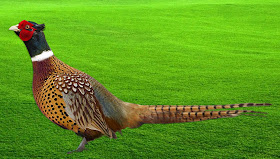The Ringneck Pheasant (Phasianus colchicus) are native to China and East Asia, but they have been successfully introduced in other parts of the world, including North America. Ringneck Pheasant is a widly introduced gamebird from Asia. Ring-necked pheasants Males are vibrantly colored with blue-green heads, red face wattles, and distinctive white neck rings. Females are a rather plain buff brown, but both sexes have long, pointed tails.
 These birds are most comfortable on the ground, where they forage for grains, seeds, berries, insects, and, occasionally, small animals. They can fly and launch themselves airborne with an abrupt, noisy takeoff, but typically run from trouble. The birds prefer fields and farmlands with brushy cover, though they also inhabit woodland undergrowth and some wetlands. Females nest in fields or in border habitat and lay a dozen or more eggs, which they incubate with no help from the cock. nesting beging in April and may last thru september. During egg laying, the hen seeks out calcium and protein. Her diet will contain 10 times more calcium than the rooster's diet. Young pheasants grow up quickly and can fly within two weeks. they develop very fast and by the time they are 15 weeks old they look like adults.
These birds are most comfortable on the ground, where they forage for grains, seeds, berries, insects, and, occasionally, small animals. They can fly and launch themselves airborne with an abrupt, noisy takeoff, but typically run from trouble. The birds prefer fields and farmlands with brushy cover, though they also inhabit woodland undergrowth and some wetlands. Females nest in fields or in border habitat and lay a dozen or more eggs, which they incubate with no help from the cock. nesting beging in April and may last thru september. During egg laying, the hen seeks out calcium and protein. Her diet will contain 10 times more calcium than the rooster's diet. Young pheasants grow up quickly and can fly within two weeks. they develop very fast and by the time they are 15 weeks old they look like adults.
The Ringneck's body plumage is barred bright gold and brown plumage with purple, white and green markings. Some of these birds have a white ring around their neck and have a bottle green head with a small-sized crest and unique red wattles. The length of an adult Ringneck pheasant male (also known as a cock) is between 76 and 89 cm with a long brown streaked black tail that measures up to 50cm. The female Ringneck pheasant (hen) has a rather dull mottled brown plumage all over the body and measures between 53 and 63 cm long; the tail is approximately 20 cm in length. Regarding their diet, these birds eat a wide variety of vegetable and animal foods, some examples would be: fruits, seeds, leaves as well as lizards, snakes and from time to time, birds. As far as the breeding aspect is concerned, they nest on the ground, producing a clutch of 10 eggs (give or take 1-2) over a period of 2-3 weeks in April-June. The incubation lasts around 23 to 26 days.
Indentification Tips:
Adult male:
Pale bill
Unfeathered red facial skin around eye
White ring around neck
Golden plumage with bluish and greenish iridescence and black spots scattered throughout
Long, pointed, golden tail feathers with black barring
Spurred legs
Adult female:
Buffy brown head and underparts
Dark brown back with paler edgings and centers
Black spots and bars scattered about head, neck and flanks
Long, buff-brown, pointed tail
Lacks spurs
Dark brown back with paler edgings and centers
Black spots and bars scattered about head, neck and flanks
Long, buff-brown, pointed tail
Lacks spurs
Physical Appearance:
Size: 24 to 35 in
Wingspan :22 to 33.9 in
Flight Speed: 38-48 mph (but can reach up to 60 mph)
Length: Males measure 24 to 35 inches long with a rooster's tail often accounting for more than 20 inches of that length. Hens are smaller with a much shorter tail.
Egg Facts:
Breeding Season : May through June
Eggs per season : 10 to 12
Broods per year: 1
Egg Color : Olive-brown
Length of Incubation: 23 to 26 Days

No comments:
Post a Comment